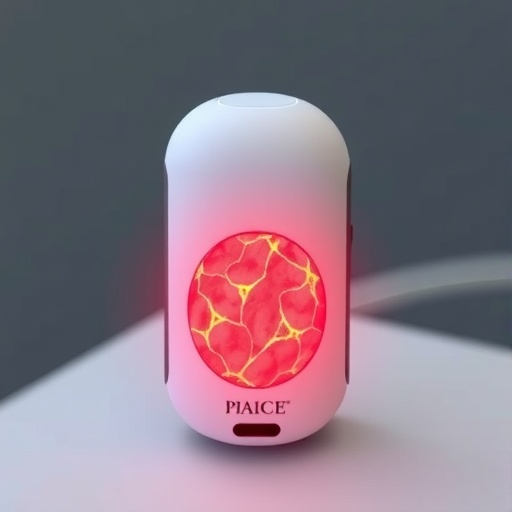As chronic wounds present a significant challenge to healthcare systems globally, innovations in wound healing technology are imperative. A pioneering wearable device named “a-Heal,” developed by a team of engineers from the University of California, Santa Cruz, is transforming wound care through the integration of real-time diagnostics and therapeutic interventions. This technology exemplifies how advancements in bioengineering and artificial intelligence can remold conventional healthcare practices, particularly in the context of managing the intricate processes of wound healing.
The healing process of a wound is complex, involving several critical stages that include clotting, immune response, scabbing, and ultimately scar formation. Traditionally, monitoring this progression and applying timely treatments has posed challenges, especially for patients with limited mobility or those residing in remote areas. The initiation of a-Heal seeks to address these challenges by optimizing each phase of healing through the combination of a compact camera and machine learning algorithms. The device’s primary goal is to ensure personalized treatment that adapts to an individual’s unique healing trajectory, thus enhancing the overall patient experience and outcomes.
The project, a collaboration between researchers at UC Santa Cruz and UC Davis and supported by the DARPA-BETR program, aims to revolutionize how wounds are treated. The design of a-Heal is groundbreaking, as it incorporates bioelectronics, an advanced camera, and artificial intelligence into a single handheld device capable of real-time monitoring and intervention. The synergy of these technologies creates a closed-loop system that not only evaluates the stage of wound healing but also administers treatments as required.
At the core of a-Heal’s functionality is a sophisticated onboard camera, engineered by Associate Professor Mircea Teodorescu. The device captures images of the wound every two hours, providing critical data for the machine learning model—referred to as the “AI physician.” This model, developed by Associate Professor Marcella Gomez, processes the wound images to diagnose healing stages. By continuously monitoring the wound, the AI can identify trends over time, flagging potential issues and suggesting appropriate treatments based on the findings.
This innovative approach synergizes real-time image data with an intelligent decision-making framework. When the onboard camera identifies a delay in the healing process, the AI physician can promptly apply treatment. This treatment may consist of delivering medication through bioelectronic actuators or applying a specific electric field to stimulate cell migration, accelerating wound closure. In preclinical tests, wounds treated with a-Heal exhibited healing rates 25% faster than those receiving traditional care, marking a significant breakthrough in the potential for rapid wound closure.
Moreover, fluoxetine, a selective serotonin reuptake inhibitor, is utilized within a-Heal’s therapeutic repertoire. This medication plays a pivotal role in minimizing inflammation while facilitating wound healing through the modulation of serotonin levels. The AI determines optimal dosages for administration, ensuring that patients receive precisely calibrated treatment based on real-time assessments. Such adaptability not only enhances the effectiveness of the treatment but also minimizes potential side effects associated with higher dosages.
The concept of reinforcement learning plays a crucial role in the operation of a-Heal. The AI model mimics the diagnostic processes utilized by healthcare professionals, learning from experiences to maximize the efficacy of its treatments. By adapting treatment protocols based on ongoing data and feedback, a-Heal exemplifies the potential of AI to deliver personalized, patient-centered healthcare solutions. The ongoing learning process ensures that the device evolves, continually refining its approach to meet the unique healing needs of each patient.
As the device gathers data on healing rates and therapy effectiveness, it transmits this information to a secure web interface where human physicians can monitor the progress. This integration not only enhances the treatment process but also provides an opportunity for healthcare providers to intervene when necessary. The convenience of attaching the device directly to standard bandages allows for seamless integration into existing treatment protocols, making it an appealing option for both patients and providers alike.
The implications for this technology are far-reaching. Chronic and stalled wounds represent a substantial burden, often leading to additional complications and extended recovery times. The ability to actively monitor and treat these wounds in real-time opens new avenues for improving patient outcomes, particularly for those unable to access traditional healthcare settings regularly. As the research team continues to explore the extensive capabilities of a-Heal, the focus is shifting toward addressing the challenges associated with chronic wounds and infections.
The unique synergy of engineering, medicine, and artificial intelligence present in a-Heal sets it apart as a paradigm-shifting innovation. By merging cutting-edge technology with patient care, researchers are poised to redefine standards in wound management. As preclinical studies yield promising results, the potential for clinical application becomes increasingly viable, paving the way for a future where rapid, effective wound healing is not just aspirational but achievable.
For those interested in the potential commercial applications of a-Heal, outreach can be facilitated through the university’s innovation transfer office. The integration of innovative medical devices into commercialized healthcare solutions is crucial for translating research into tangible benefits for patients. With continued support from organizations like DARPA, the dream of optimizing wound care through technology is becoming a reality.
In summarizing, the journey of a-Heal represents a pivotal advancement in the intersection of healthcare and technology. By harnessing the intricacies of AI, bioelectronics, and real-time diagnostics, this innovation stands at the forefront of modern medicine, illustrating the power of collaboration in achieving groundbreaking results. As we look to the future, the ongoing enhancement of wound healing protocols promises to significantly impact patient care across diverse medical landscapes.
Subject of Research: Wound healing technology using bioelectronics and AI.
Article Title: Towards adaptive bioelectronic wound therapy with integrated real-time diagnostics and machine learning–driven closed-loop control.
News Publication Date: 23-Sep-2025.
Web References: Nature Article.
References: Deep Mapper Study, Reinforcement Learning Details.
Image Credits: Credit: Rolandi et al.
Keywords
AI, wound healing, bioelectronics, wearable technology, personalized medicine, chronic wounds, machine learning.
Tags: advancements in bioengineeringAI-powered smart devicebioelectronics in healthcarechronic wound management solutionsDARPA-BETR programhealthcare innovationsmachine learning in medicinepersonalized wound treatmentreal-time wound monitoringUC Santa Cruz researchwearable health deviceswound healing technology





